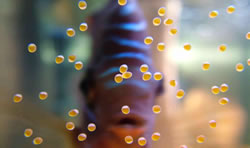 Bettas feed on a wide variety of fresh or frozen foods. However, they can also be notoriously picky.
Bettas feed on a wide variety of fresh or frozen foods. However, they can also be notoriously picky.
Luckily, there are many dietary options for betta fish that you can choose from.
Bettas are carnivorous and thrive well on live tasty treats such as worms, crustaceans, and small insects.
Here are six of the healthiest food choices for your betta fish:
- Mosquito Larvae
In their natural habitat, the staple food of bettas are mosquito larvae, however, aquarists may have a difficult time securing larvae to feed their bettas. If you find mosquito larvae floating in water, make sure the water is not dirty before harvesting the larvae or you might bring disease back into your fish tank. If you live in an area with a high population of mosquitoes, you can collect the larvae and store them for up to two weeks inside a covered jar placed in the refrigerator.
- Microworms and Mini-microworms
Microworms are considered to be the easiest live food to culture for feeding betta fish. They are also good sources of nutrients for baby Bettas. Culturing microworms is relatively easy and you can harvest your first batch of worms in about 3-4 days. When you choose to culture your own microworms, make sure to reserve some worms to be used as a starter culture. Mini-microworms, also called Waterworms, are smaller versions of the Microworms. These are excellent for feeding the very tiny fry of Bettas.
- Live Brine Shrimp
Brine shrimps, also referred to as artemia, are high in nutrients required by Bettas. There are betta owners who set up their own shrimp hatchery to ensure the wholesomeness of the live food they’re giving their pets. While live baby brine shrimp are best fed to betta fry, you can use both adult and baby shrimp for your adult bettas.
- Daphnia
Daphnia abound in small pools, ponds, and ditches, and look like very small freshwater shrimps. In the past, these were considered the best fish food by aquarists. Since wild daphnia may increase the risk of introducing diseases, parasites, and toxic substances to your fish, it is better to start your own culture. There are several types of Daphnia commonly available—Daphia magna( the biggest), Daphnia pulex, and Daphnia moina (the smallest).
- Bloodworms
Bloodworms are larvae of a species of midge fly. Its characteristic red color is caused by the iron component, porphyrin, in its blood and tissues. Bloodworms contain 6-8% protein and are natural sources of iron. Since they lack some essential amino acids needed by bettas, it should be fed with other viable sources of amino acids and other nutrients. Many betta keepers give bloodworms as treat once or twice a week.
- Earthworms
Earthworms are also excellent sources of protein for Bettas that are often overlooked. You can collect earthworms in your backyard or buy some at the fish bait store, and place them in a jar in the refrigerator. You may need to cut earthworms into bite-sizes.
About the Author:
Peter Hartono is the founder and CEO of Just Aquatic - a proud Australian company that offers homegrown aquatic plants and aquarium supplies carrying top of the line brands including API, biOrb and Exo Terra. To find out more of our exciting offers and promotions check out our Facebook Page and follow us on Twitter at @justaquatic.

